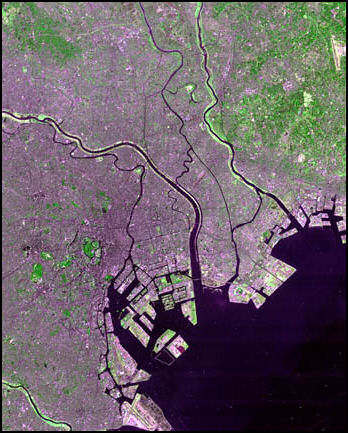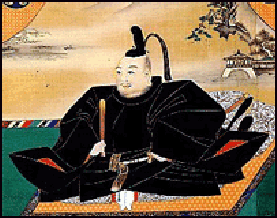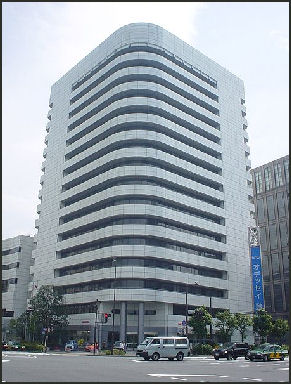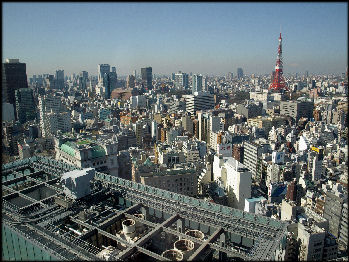TOKYO BASICS

Tokyo from space TOKYO means "new capital," but "endless city" seems like a more apt description for it. Situated on the Kanto Plain of central Honshu island, next to Tokyo Bay on the Pacific Ocean, it cover 2,194 square kilometers (847 square miles) and just keeps going and going and going, seeming all the way to Nagoya, Mt. Fuji and Nikko, which all more than a hundred miles away in different directions.
What is perhaps even more amazing is how densely packed Tokyo is. Dwelling, offices, highways, factories, vehicles, shops, and entertainment centers are all squeezed close together and packed one top of another, in a Blade-Runner sort of way, emitting constant steams of people. Sometimes it seems all you can do it is throw yourself into the crowd and let it carry you.
Tokyo is the capital of Japan. It is home to most large domestic corporations, foreign companies, and the head offices of the mass media. Tokyo is also a center of education. The city is famous as a center of culture and entertainment. It offers a variety of modern and traditional arts. Classical and popular music are performed at Tokyo’s many concert halls, and there are numerous museums and art galleries. Metropolitan Tokyo consists of the 23 wards of urban Tokyo, 26 cities, 5 towns, and 8 villages.
It as been said that Tokyo doesn’t need a Disneyland because it is like a theme park in itself. The crowds, the density and the endlessness are make Tokyo both stimulating and frustrating and creates a multitude of places to explore and make new discoveries and get lost in. Each neighborhood, shopping area, Buddhist temples, Shinto shrines, subway car and group of people seems likes its own little galaxy within a larger universe made of clashes between old and new that is always changing and renewing itself
Shopping centers with diode images and gimmicky electronics, and sleek modern buildings with shock absorbers for earthquakes, provide a backdrop for women in kimonos and monks with shaved heads and robes. Parks with cherry blossoms trees and open spaces in front of stunning modern architecture provide places for Teddy-boy yangqis, heavily made-up Gothic Lolitas, cosplayers and posers to be seen, housewives to catch their breath and office workers to get drunk.
And in the midst of all that, Tokyo is a busy, functioning city. It is the government, administration, finance and cultural center of Japan, performing all the functions of Washington D.C., Los Angeles and New York. Tokyo embraces one district (in a mountainous and lightly inhabited area) and 39 municipalities. The main Tokyo government building is in Shinjuku. There isn't that much old or historic stuff but there is a lot of culture, both Japanese and Western. And if you are into the new Tokyo is the place.
Websites: Tokyo Metropolitan Government metro.tokyo.jp; Go Tokyo, Official Tokyo Travel Guide gotokyo.org ;; Wikipedia Wikipedia
History of Tokyo

Tokugawa IeyasuTokyo has only been the official capital of Japan since 1868 when the Meiji Emperor moved the capital from the court in Kyoto to the castle town of Edo (Tokyo). Despite this late formal move, Edo had been the administration center of the country since the early 17th century when Tokugawa Ieyasu unified the nation, built Edo Castle and established the Tokugawa Shogunate. By the mid 18th century the city has over a million inhabitants and was was a large, bustling metropolis that thrived and grew despite fires and earthquakes.
Tokyo was originally known as Edo ("Gate of the Estuary"), a reference to its location on the mouth of the Sumida River. Edo was also the name of a major historical period between 1603 and 1867 that began when Tokugawa Ieyasu — one of Japan’s most important leaders — became the ruler of Japan and moved his court to Edo from Kyoto, which remained the Imperial capital and the home of the powerless Emperor.
Under Tokugawa Ieyasu Edo began as a military installation and was founded where it was because it was far from Kyoto and was fairly centrally located among Japan’s far flung feudal states. Edo was a village when it was founded in 1590. Within 20 years it mushroomed into a city with a large castle and 200,000 people. By 1695, it had 800,000 people, making it the largest city in the world. In the 18th century the population grew to 1.3 million. At that time, Edo was said to have been well planned and organized and had lots of trees and greenery. About 70 percent of the city was occupied by residences. Merchants and artisans worked and lived in areas partitioned according to their trades.
During the Edo Period, Edo was the home of the Tokugawa shogun (the ruling descendants of Tokugawa Ieyasu). The Tokugawa dynasty was so formidable that the castle and city it created was never attacked. Tokyo’s phenomenal growth was due to the fact that the shogun required the 260 daimyos (ruling lords) who lived in Japan to spend some of the their time in Edo. As was the case in cities around the world, the well connected and wealthy lived well but the poor suffered, living in crowded conditions. The emerging merchant class helped drive the development of a vibrant, popular culture scene.

Hiroshige's Sugura Street The city’s name was changed from Edo to Tokyo ("new capital") in 1869, after the Tokugawa shogunate was overthrown and the Imperial Capital of Japan was moved from Kyoto to Tokyo and the Emperor moved from the Imperial Palace in Kyoto to Edo Castle, which was later the renamed the Imperial Palace. The city began to take on a unplanned haphazard quality at this time as 35,000 samurai families were forced to leave and the area they vacated was redeveloped. Green spaces were regarded as vacant areas that could be filled with buildings.
Despite its size Tokyo has relatively few old buildings because it has had to constantly rebuild itself from scratch after typhoons, fires, earthquakes (Tokyo averages three tremors day), tsunamis and floods. Much of Tokyo was destroyed by the great Tokyo Earthquake of 1923, which caused great fires and killed over 140,000 people. During World War II almost half of Tokyo was left in ruins by American fire bomb raids. Most of structures in the city today have been built since World War II.
Even without natural disasters buildings and neighborhoods in Tokyo have been periodically raised and redeveloped. As on 2003, there were 600 development projects underway in Tokyo. But these projects do little to dispel the image of Tokyo as a mess desperately in need of urban planning. Preservationists are becoming increasingly active in their effort to save traditional structures from the wrecking ball. But thus far they have proved to be only a minor irritation to developers. New buildings continue to go up. Entire neighborhood are redeveloped. People who return to places they haven’t been in years hardly recognize them any more.
Website: Wikipedia Wikipedia Book : “Edo, The City That Became Tokyo: An Illustrated History” by Akira Naito (Kodansha Press, 2003).
People and Population of Tokyo

Although Tokyo is no longer regarded as largest city in the world on some lists (its follows Mexico City, São Paulo, and New York City, depending on the source), the greater Tokyo-Yokohama area is regarded as the largest metropolitan area in the world, and sometimes the endless suburbs and satellite towns around it seems to stretch all the way to Osaka, 250 miles away.
Tokyo is home to around 13.5 million people and has a population density of 6,168 people per square kilometer. The Tokyo metropolitan area has 20 million, and the Tokyo-Yokohama area has 26.5 million people. The greater Tokyo area, which now occupies nearly the entire Kanto Plain, embraces about 38 million people, almost five times the population of Sweden. By most reckonings Tokyo is the world’s largest metropolitan area with 36 million people, followed by New York City with 19.04 million.
Tokyo-Yokohama had a population of 1.5 million in 1900. It grew from 6.2 million in 1950 to 27.7 million in 2000. It is expected to reach 28.7 million in 2025. Although the Tokyo area only occupies 4 percent of Japan's land one fourth of Japan’s population lives there. The people of Tokyo are called Tokyoites.
People from Tokyo and Kanto are regarded as busy, cold, impersonal, polite, formal and stressed out. They are less likely to have a desire to stand out and they favor brown, gray and earth-toned colors. Many of the stereotypes that are used to describe Japanese as a whole seem more apt for Tokyoites than Japanese outside of Tokyo. Tokyo is where the samurai class was based in the Edo period and the culture has a long history of obedience, duty and following rules.
Tokyoites and Osaka people are the two dominate groups in Japan. Sometimes they have different customs. In Tokyo people stand on the left of escalators and pass on the right. The opposite is true in Osaka. The Tokyo dialect is the standard Japanese heard in news broadcasts and in the Tokyo area. The Kansai dialect is the dominant form in “owari bangumi” entertainment programs as many comedians and entertainers are from the Kansai and make many jokes in the Kansai dialect.
Tokyo Economy

Honda headquarters
Tokyo has the largest metropolitan economy in the world. According to a study conducted by PricewaterhouseCoopers, the Greater Tokyo Area (Tokyo-Yokohama) with 38 million people had a total GDP of $2 trillion in 2012 (at purchasing power parity), more than any other metropolitan economy in the world.
In Japan there is an extraordinary concentration of economic power in Tokyo. The greater Tokyo region represents one-third of the nation's economic output. Marcus Noland wrote in the Washington Post, “Over the past 10 to 20 years, hundreds of Japanese corporations have moved their headquarters from cities such as Osaka and Kitakyushu to the Japanese capital. The nation's transition to a post-industrial society (with its greater emphasis on white-collar services), the decline of regional financial institutions and a cultural emphasis on face-to-face communication in business have encouraged the clustering of economic life in Tokyo. But post-earthquake rebuilding could help spread economic activity across the country. If pursued creatively, this could help jump-start an entirely new source of economic strength in northern Japan. [Source: Marcus Noland, Washington Post, March 16, 2011]
Tokyo's city budget of $41 billion in 2000 was approximately equal to the GNP of India. By some estimates the economic activity generated in the 783 square miles of the greater Tokyo-Yokohama metro area today is equal to the economic activity generated by France.
Land prices in Tokyo, although not as high as they once were, are still among the highest in the world. One office building in downtown can be worth a billion dollars. A simple wood frame house, not much bigger than a big shed, or modest apartment can go for $1.5 million or more. In the heart of the Ginza district land goes for as much as $10,000 a square foot, which down from $20,000 a square foot in the Bubble Economy years in the late 1980s. Tokyo is expected to be surpassed by Shanghai in economic size in 2015 and by Singapore by 2025.
Tokyo consistently ranks as one of the world's most expensive cities. Most expensive cities for expatriates according to the 2008 Mercer Cost of Living survey: 1) Moscow; 2) Tokyo; 3) London; 4) Oslo; 5) Seoul. According to a survey by ECA International Tokyo is the most expensive city
Average annual rental prices per square foot for a top-end office space in 2006:1) West End, London, $212; 2) Central Tokyo, $146; 3) The City, London, $145; 4) Outer Central Tokyo, $134: 5) Hong Kong, $116; 6) Moscow, $109; 7) Mumbai, $106; 8) Paris, $106.
Tokyo Development and Infrastructure

In the Bubble Economy period, Tokyo experienced a building boom of high price skyscrapers like $1.3 billion town hall, and expensive public works projects. Spending continued after the Bubble Economy collapsed causing Tokyo to tun up huge debts. In 1998, the $1.5 billion Tokyo International forum performing arts center opened around the same time Tokyo’s governor said the city nearly bankrupt. But development has continued. Between 2001 and 2006, 140 buildings 30 stories or more were completed, under construction or proposed, third in the world behind Hong Kong and Dubai
To relieve congestion Tokyo has underground highways that go under buildings and doughnut interchanges. One doughnut at Ohashi Junction in Meguro ward is as a building as large as a stadium. It connects the Shinjuku Route Expressway, which is 35 meters underground, with the Expressway Route 3 Shibuya, which is 35 meters above ground. To go from one expressway to the other one has do loop inside the doughnut 2 ½ times. Plans to construct Tokyo’s biggest avenue, 80-meter-wide MacArthur Road, is expected to cost tens of billions of dollars.
Tokyo and the Environment
All of Tokyo’s progress has not come without a price. Only 10 percent of Tokyo is open space compared to 34 percent in Washington D.C., and because of air pollution Mount Fuji is only visible 78 days a year (but this better than 1965 when you could see it only 13 days).
Even so Tokyo is amazingly clean for a city of its size. Levels of particles of smoke in Tokyo in the 1990s were around 50 micrograms per cubic meter compared to 400 in Calcutta, 380 in Beijing, 280 in Jakarta, 120 in Hong Kong, 100 in Bangkok, 95 in Manila and 60 in New York.
Pollution in Tokyo was much worst in the past than it is now. In the early 60s traffic policeman used to carry small cylinders of oxygen with them for relief from the heavy doses of car exhaust fumes they breathed in ever day. Ordinary people wore gas masks and bought oxygen from vending machines. An electric sign near the Ginza gave the time and temperature as well the current sulphur dioxide, carbon monoxide and noise levels.

Around 1970 children were collapsing on playgrounds and doctors were busy taking care of patients with a respiratory disease called "Yokkaichi asthma." When the situation was no longer tolerable the government began offering tax breaks for pollution-reduction measures and companies took measures in their own realizing it was more cost-effective to have healthy workers.
Industrial pollution has been greatly reduced through emission-reduction programs. In Kawasaki, one of the Tokyo area’s main industrial hubs, sulphur dioxide has been reduced 96 percent by installing scrubbers and switching fuels. Certified victims of pollution before 1970 get special government-subsidized medical treatment.
In recent years efforts have been focused on reducing automobile emissions. In the mid 2000s, a Tokyo government a law that requires all diesel-powered vehicles to install exhaust filters went intro effect.
Tokyo has many electronic-display pollution monitors that show noise levels and the amount of carbon monoxide, sulfur dioxide and nitrogen oxide in the air. If pollution reaches dangerous levels loud speakers goes warn young children, seniors and people with respiratory problems to stay indoors.
Tokyo Weather and Tourism
Tokyo has four distinct seasons and the weather is comparable to that of New York or Washington D.C.. Summer is hot and humid with temperatures often reaching 35°C (95°F), Autumn is comfortable and the warm weather can coninue into November. Winter is cold, sunny and dry with occasional light snowfalls and temperature sometimes dropping below freezing. Spring is mild with scattered showers. Mid-June to mid-July is the rainy season. Typhoons can occur from May to November but are most common in August and September.
Tokyo is the major gateway to Japan for many tourists. Visitors to the city can enjoy Kabuki and Noh dramas as well as thousands of restaurants and bars. Museums and art galleries are located throughout the city and there is an endless number of shopping districts, high tech buildings and colorful neighborhoods to explore.
Tokyo can be expensive. A taxi cab fare from Narita airport to downtown Tokyo can cost as much as $175 and a box of cherries at a Tokyo supermarket can go for as much a $250, which works out to almost $2.30 cents a cherry.
But don’t let that scare you off there a plenty of bargains, cheap restaurants and things to do for free. Just walking the streets can be an adventure, especially in the neighborhoods where new fashion trends are born, torn down and replaced. Hotel prices are on par with those of any large city with the cheapest option in Tokyo being $35-a-night capsule hotels.
Image Sources: 1) NASA 2) 3) 5) Wikipedia 4) Andrew Gray Photosensibility 6) Ray Kinnane 7) JNTO
Text Sources: JNTO (Japan National Tourist Organization), Japan.org, Japan News, Japan Times, Yomiuri Shimbun, UNESCO, Lonely Planet guides, New York Times, Washington Post, Los Angeles Times, National Geographic, The New Yorker, Bloomberg, Reuters, Associated Press, AFP, Compton's Encyclopedia and various books and other publications.
Updated in July 2020
